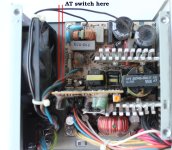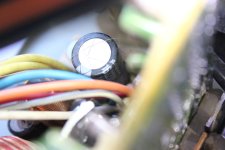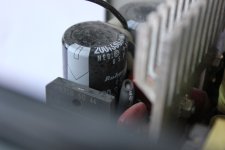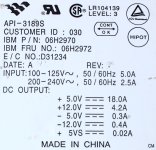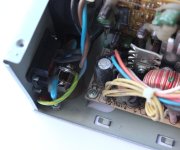Greetings friends,
I have this 6571 motherboard with its proprietary PSU (nice Rubycon caps), it has no power switch but a proprietary 3-pin connector that plugs into the MB.
This connector has 3 cables, colored black, white and red.
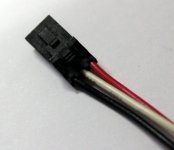
I measured it when the PSU is on, and red is 5v, black GND, but the white cable is not -5v. When the PSU is on, the white cable measures 0.33v, when it's off, it measures full 5v.
If you use a regular PSU the MB gets the right power but it refuses to even POST, no errors though, no beeps.
In the past when I was braver and more foolish, I remember wiring the header of this connector to a regular PSU based on the colors (red 5v, black GND and white -5v) and the MB worked with a regular PSU. But now that I have a little more experience I don't think it's safe to wire the white cable to -5v. I'm ready to do more measurements and tests if you can give me directions and find out what's best way to adapt this MB to use a regular PSU.
Next to this connector's header there are two undocumented jumpers that are open WP JP1 and JP2. Maybe changing them to close would allow me to use a regular PSU?
One more thing about this IBM PSU is that when it's on stand-by mode it makes an audible clicking noise which is quite unsettling since I don't see the fan running. What would that be and why is this PSU so strange?
Merry Christmas and happy new year!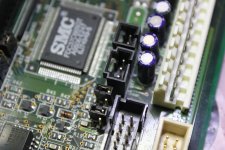
I have this 6571 motherboard with its proprietary PSU (nice Rubycon caps), it has no power switch but a proprietary 3-pin connector that plugs into the MB.
This connector has 3 cables, colored black, white and red.

I measured it when the PSU is on, and red is 5v, black GND, but the white cable is not -5v. When the PSU is on, the white cable measures 0.33v, when it's off, it measures full 5v.
If you use a regular PSU the MB gets the right power but it refuses to even POST, no errors though, no beeps.
In the past when I was braver and more foolish, I remember wiring the header of this connector to a regular PSU based on the colors (red 5v, black GND and white -5v) and the MB worked with a regular PSU. But now that I have a little more experience I don't think it's safe to wire the white cable to -5v. I'm ready to do more measurements and tests if you can give me directions and find out what's best way to adapt this MB to use a regular PSU.
Next to this connector's header there are two undocumented jumpers that are open WP JP1 and JP2. Maybe changing them to close would allow me to use a regular PSU?
One more thing about this IBM PSU is that when it's on stand-by mode it makes an audible clicking noise which is quite unsettling since I don't see the fan running. What would that be and why is this PSU so strange?
Merry Christmas and happy new year!


